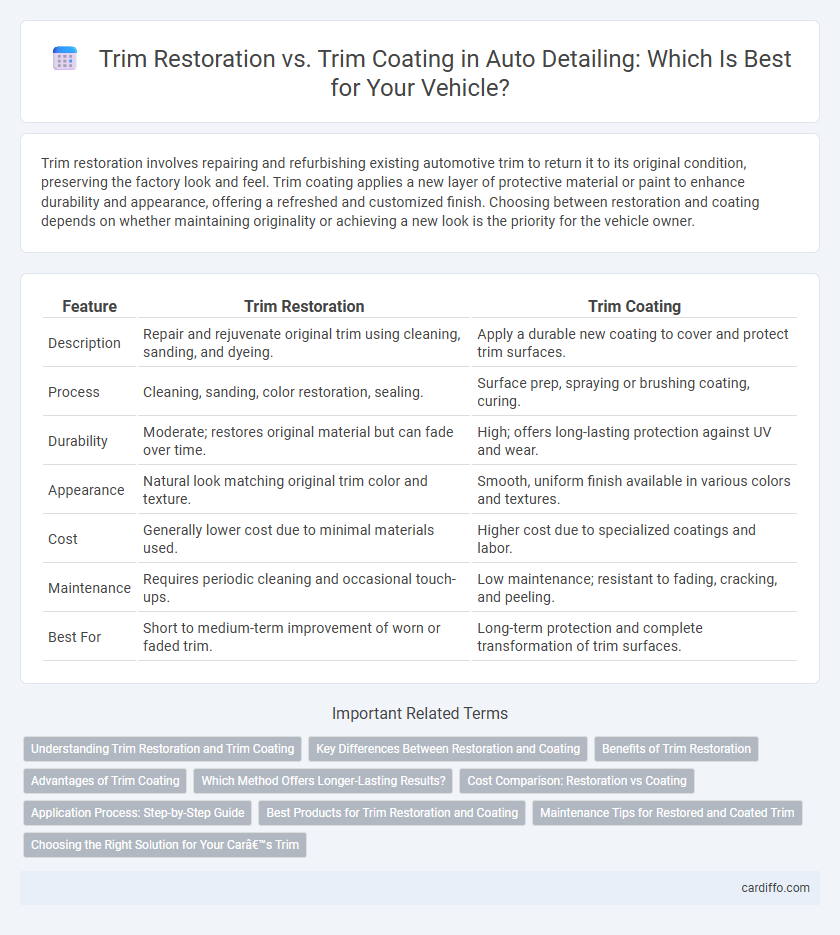Trim restoration involves repairing and refurbishing existing automotive trim to return it to its original condition, preserving the factory look and feel. Trim coating applies a new layer of protective material or paint to enhance durability and appearance, offering a refreshed and customized finish. Choosing between restoration and coating depends on whether maintaining originality or achieving a new look is the priority for the vehicle owner.
Table of Comparison
| Feature | Trim Restoration | Trim Coating |
|---|---|---|
| Description | Repair and rejuvenate original trim using cleaning, sanding, and dyeing. | Apply a durable new coating to cover and protect trim surfaces. |
| Process | Cleaning, sanding, color restoration, sealing. | Surface prep, spraying or brushing coating, curing. |
| Durability | Moderate; restores original material but can fade over time. | High; offers long-lasting protection against UV and wear. |
| Appearance | Natural look matching original trim color and texture. | Smooth, uniform finish available in various colors and textures. |
| Cost | Generally lower cost due to minimal materials used. | Higher cost due to specialized coatings and labor. |
| Maintenance | Requires periodic cleaning and occasional touch-ups. | Low maintenance; resistant to fading, cracking, and peeling. |
| Best For | Short to medium-term improvement of worn or faded trim. | Long-term protection and complete transformation of trim surfaces. |
Understanding Trim Restoration and Trim Coating
Trim restoration involves repairing and revitalizing original vehicle trim by removing scratches, fading, and oxidation to bring back its factory appearance. Trim coating applies a protective layer, such as ceramic or vinyl, over the trim to enhance durability, color, and resistance to UV damage. Both methods improve aesthetic appeal, but restoration targets existing material repair, while coating focuses on surface protection and longevity.
Key Differences Between Restoration and Coating
Trim restoration involves repairing and revitalizing the original material by removing scratches, fading, and oxidation to return it to its factory condition. Trim coating applies a protective layer or paint over the existing trim surface, enhancing durability and appearance without altering the underlying material. Restoration focuses on preservation and original finish recovery, while coating emphasizes protection and aesthetic enhancement.
Benefits of Trim Restoration
Trim restoration preserves original factory finishes, maintaining the vehicle's authentic look and value more effectively than trim coating. Restored trim often lasts longer because it repairs surface damage rather than covering it, enhancing durability against UV rays and environmental wear. This process typically requires less material and labor, making it a cost-effective option for improving trim appearance.
Advantages of Trim Coating
Trim coating offers enhanced durability by creating a protective layer that resists fading, cracking, and UV damage, extending the lifespan of automotive trim surfaces. This process ensures a smoother, more uniform finish that improves aesthetics and maintains vehicle value over time. Compared to trim restoration, trim coating provides superior protection against environmental wear and chemical exposure, reducing the need for frequent maintenance.
Which Method Offers Longer-Lasting Results?
Trim restoration involves repairing and refurbishing original materials to maintain the vehicle's authentic look, typically offering durable results dependent on the condition of the trim. Trim coating applies a protective layer or new finish over existing surfaces, providing enhanced resistance to UV damage and wear, often extending the lifespan of the trim beyond restoration alone. Evaluating longevity depends on factors such as trim material, environmental exposure, and maintenance, with trim coating generally delivering longer-lasting protection against fading and cracking.
Cost Comparison: Restoration vs Coating
Trim restoration typically costs between $150 and $400 depending on damage extent, while trim coating generally ranges from $200 to $600 due to materials and application complexity. Restoration involves cleaning and repairing existing trim, making it more cost-effective for minor wear, whereas coating applies a new protective layer, increasing durability but also total expense. Choosing between restoration and coating depends on budget constraints and desired longevity of trim appearance.
Application Process: Step-by-Step Guide
Trim restoration involves carefully cleaning, sanding, and repairing damaged or faded trim to bring back its original texture and color, followed by applying paint or dye to match the existing trim. Trim coating requires surface preparation through thorough cleaning and light sanding, then applying an adhesion promoter before spraying multiple layers of durable coating for a uniform finish. Both processes demand drying and curing times between each step to ensure a long-lasting and professional appearance.
Best Products for Trim Restoration and Coating
Best products for trim restoration include Meguiar's Ultimate Black Plastic Restorer and Chemical Guys VRP Vinyl, Rubber & Plastic Protectant, which effectively revive faded trim by penetrating and conditioning surfaces. For trim coating, CarPro PERL and Gtechniq C4 Permanent Trim Restorer offer long-lasting, hydrophobic protection with a durable finish that resists UV damage and oxidation. Selecting high-quality trim restorers and coatings ensures enhanced longevity, improved appearance, and superior protection against environmental wear.
Maintenance Tips for Restored and Coated Trim
Maintaining restored and coated trim involves regular cleansing with a mild detergent and a soft brush to prevent dirt accumulation and preserve the surface finish. Avoid abrasive materials and harsh chemicals that can damage or dull protective coatings, ensuring longevity and a consistent appearance. Applying a UV-protectant spray periodically helps safeguard against sun damage and fading, extending the trim's lifespan.
Choosing the Right Solution for Your Car’s Trim
Trim restoration revitalizes worn or faded trim by repairing damage and restoring original textures and colors, ideal for preserving authentic factory finishes. Trim coating involves applying a durable, protective layer that changes the trim's appearance while enhancing resistance to UV rays and environmental wear. Selecting between restoration and coating depends on the trim's condition, desired aesthetics, and long-term maintenance goals for optimal vehicle appearance and value.
Trim Restoration vs Trim Coating Infographic

 cardiffo.com
cardiffo.com